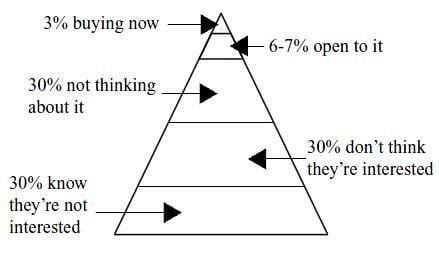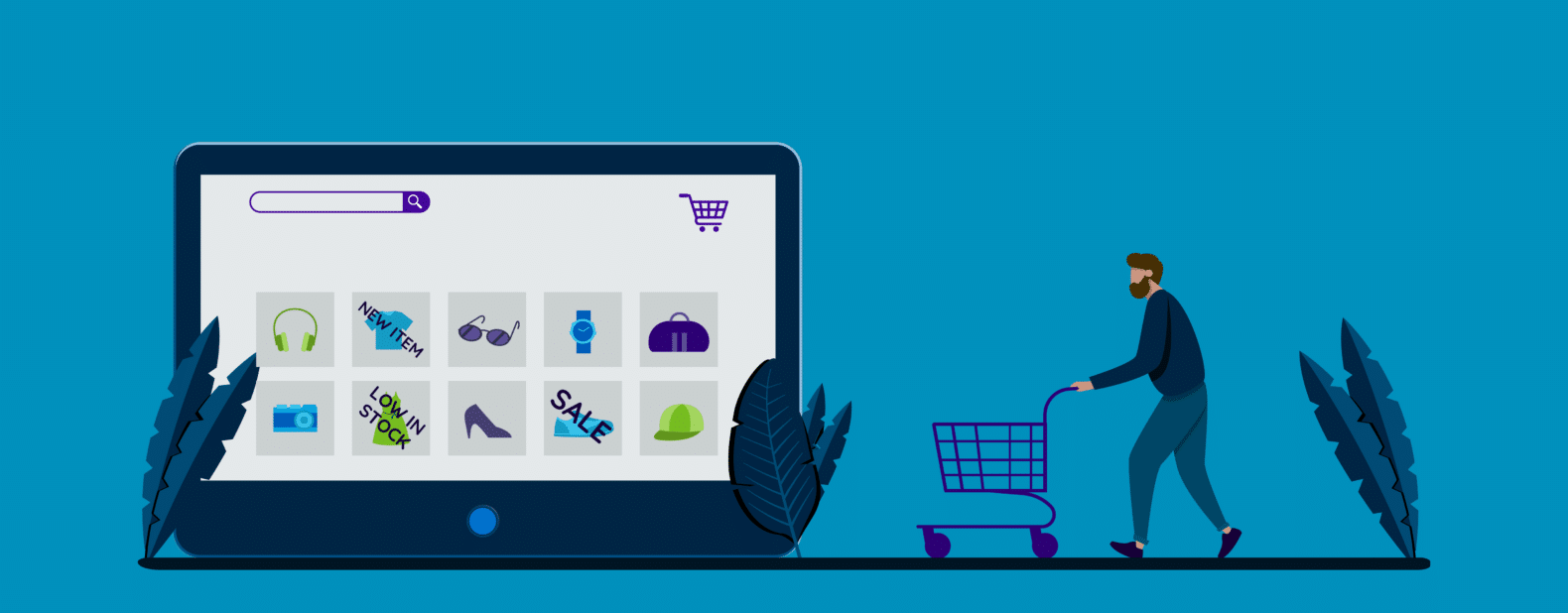When it comes to running a business, most entrepreneurs have the same goal and that’s to make money. What’s often not leveraged is a robust and diversified marketing strategy that speaks to every type of buyer. Not having a strategy that incorporates a thorough understanding of how you need to speak to each type of buyer is costing a lot of business owners more than they know. Luckily for you, I am a trained salesperson who lives for understanding the psychology of buyers. Below I will walk you through the audiences that exist and what you need to be doing in order to attain their business.
Buyer’s Pyramid
Now I know what you must be wondering, “You don’t sell products, you sell services so how does this apply to me?” Well, having been in sales working to assist e-commerce business owners for my entire professional career, I’ve found that there’s a large overlap in how to approach our mutual goals of growth. I want to showcase what may be of the most value to any and all business owners, just like you, seeking this goal of growth using what’s called, “The Buyers Pyramid.” The Buyers Pyramid, as showcased below, is one of the most powerful principles when it comes to sales.

What’s most eye opening about this chart, is the miniscule percentage of people ready to buy your products at any given moment. Where a lot of businesses make their first mistake is focusing most of their marketing efforts to this tiny pool of people. These people are the ones you may be running branded ads to; they’re already aware of your brand and just need to see it pop up in front of them to convince them to buy. The remaining 97% of the market needs more attention in order to be converted into buyers.
4 Types of Buyers
Cheap Buyers
There are four types of shoppers that occupy this buyer’s pyramid beneath that top 3% and it is essential to understand these groups in order to attract their business. The first type of buyers are the cheap buyers. These are the people that buy based on price and not as much on the value that you provide. They are always on the hunt for the next best deal. Your strategy needs to include areas that offer deals and discounts for this group. Great plans of action to attract this pool of buyers include email marketing, where you can set up automations with coupons and discounts for visitors that view/add products on your website and leave without purchasing. You also want to improve your PPC (Pay-Per-Click) campaigns to include discounts for the holidays or relevant seasonal spices to your industry.
Difficult Buyers
The next type of buyers are the difficult buyers. No matter what you do or how much information you provide, they just don’t buy. This is the pool at the bottom of the pyramid. While this article is about how to attract the rest of the buyers, it is important for every business owner to know you can’t attract everyone. This is important to note when launching new strategies or campaigns. It takes time to gather appropriate data to ensure that tweaks and adjustments are made to filter out as much of this group as possible. Knowing about this group serves as a great reminder as to why results don’t happen overnight.
Sophisticated Buyers
Getting back into the groups you still have the power to win over brings us to our third type of buyers, sophisticated buyers. They buy based on the value the product will bring them and ensure they are making the right decision by doing as much research as possible. They are going to come to their own conclusion, but it is your job to provide them with information that helps them along the process. In order to accomplish this goal, shoppers need to have access to information in as many places as possible. This includes making sure you have a strong “About” page on your website that relies on visual storytelling.
While these buyers are diligent about research, they are still internet users with short attention spans so don’t force these people into a position to do more reading then they have to. Leave the wordier content to the areas they expect to do more reading, like your blog. You need to ensure that you’re not only providing consistent information (we recommend at least 2 articles a month), but that this content answers the specific questions your audience is looking for. All articles need to be optimized on the backend (SEO) in order to make it an easy and quick process for researchers to find your brand. A strong, visual “About” page, and strategically managed SEO is just the tip of the iceberg when it comes to speaking to these buyers, but it’s an excellent place to start.
Affluent Buyers
Last, and certainly not least, are the affluent buyers. They buy based on feelings, emotions, and convenience. Now understanding these buyers is more than just knowing about the fourth type of buyer. The key here is understanding how people buy with their emotions; which is the number one reason people buy! People don’t buy because of logic, they buy because of emotion and justify with logic. Think about something you want to buy in your life. Once you have it, ask yourself this question, “Why do I want to buy this?” If you peel through the layers, my guess is you’ll realize your buying emotions.
With that said, think about when you’re selling to someone. Are you just talking about your features and benefits? This is very generic, especially in highly saturated industries, and screams “me, me, me.” You want to make sure your brand is speaking and relating to the specifics of your target audience. Find out what your audience wants to know and pull on emotional strings to let them know how the product will benefit them, not just why the product is awesome.
Having this sort of approach makes you stand out from your competitors because visitors will feel like your brand was made with them in mind, striking hard at those emotions that lead most people to buy. This is accomplished through strong brand identity. You must create and control a cohesive buyer journey for your audience at every point they can interact with your brand. At every point a shopper interacts with your brand, you must make sure they understand why they should be buying to ensure they always feel like they’re being spoken to directly. This includes everything from website design and content, ad copy, and the unboxing experience with custom package design, etc.
As you can see, a majority of the people you need to be marketing to aren’t people ready to buy your products at any given moment. In order to take the most advantage of speaking to the large majority of the remaining marketplace, you need a well diversified marketing strategy that speaks to the four main types of buyers. If you have any questions on what action steps you should take, or need help to implement certain initiatives, contact our team and we’d be happy to help!
